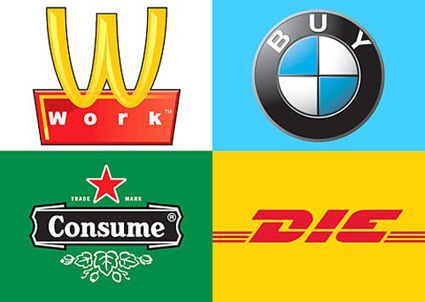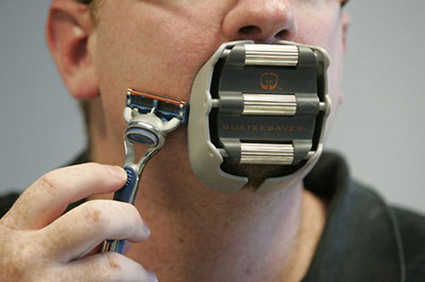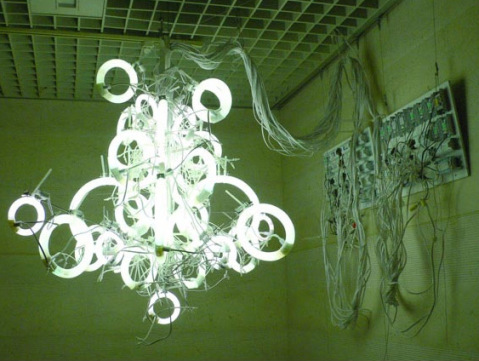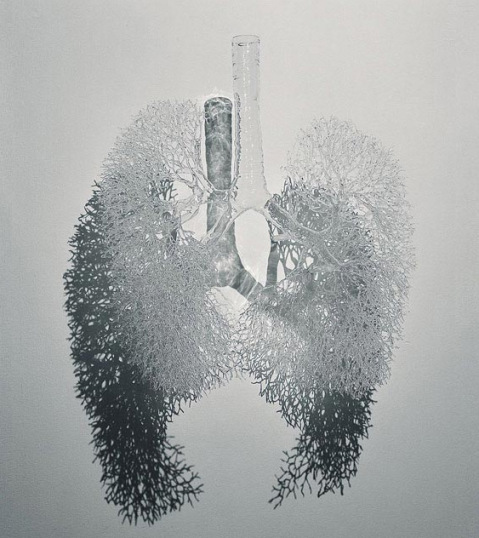
Pretty much sums up our lives, doesn’t it?
[by Bas de Reuver]
I think we are on the verge of surpassing the what animators term as the ‘uncanny valley’:
For many years now, animators have come up against a barrier known as “uncanny valley”, which refers to how, as a computer-generated face approaches human likeness, it begins take on a corpse-like appearance similar to that in some horror films.
As a result, computer game animators have purposely simplified their creations so that the players realize immediately that the figures are not real.
The animation above is being done by Image Metrics (who are behind popular computer/video game Grand Theft Auto). We’re still not able to do this on-the-fly. Massive amounts of computations are required to calculate and control every little movement – every little twitch of the eye, the sneer, the muscles that contracts under the skin, etc.
But with chip technologies and architecture developing, it’s certainly not a pipe-dream to envision some day in the very near future where this becomes common place. What does it mean for us in the real world when we cannot distinguish the real from the fake? At a massive, ubiquitous level?
Really amazing animation – check out Times Online for a more comprehensive article.

I admire anyone who is willing and able to take the plunge in bringing their ideas/inventions to market – it definitely take a lot of guts and determination. But, this ‘goatee saver‘ still goes into the ‘Unreal’ book for me:
‘Tired of the constant struggle every morning trying to get your goatee to look perfect? Goateesaver revolutionizes the way you shave and trim your goatee. goateesaver can be customized to your face in seconds, with three easy adjustments. Just slide it over your mouth and shave to get the perfect look that women will admire and men will respect.’
The three knobs are extendable towards the side – this will help to define the outline of the shape. You then bite onto a mouthpiece, turn yourself into Darth Vader and then use any normal razor to shave along the perimeter. If that still doesn’t explains it, here’s the video:
What do I know though – there could be a ready market of goatee-wearers who always wanted something like this. If he really does make millions of it, it can probably join this honored list.
How many Top-100 most common English words can you name in 5 minutes?
That is the premise of this simple game from Codebox Software, aptly titled ‘The 100 most common English Words’. As a person who dabbles in writing almost everyday, I thought this would be peanuts. I got a bare passing mark – 51/100. What about you?
Bombay Sapphire has always been somewhat the Patron Alcohol of the design scene – you can see their presence in virtually every major design show. Traditionally they’ve also organized an annual design competition with the theme of designing a martini glass to contain their liquid in. This year, however, it seems like they’ve taken on a different subject.
‘Glass’ was the focus – not just the vessel holding the gin – but the material itself.
Glass is an everyday material that in the hands of a talented artist or designer can be transformed in countless ways to produce stunning results. To spotlight contemprorary glass and to reward the creativity and expertise of artists, designers and architects working with glass, the BOMBAY SAPPHIRE Foundation launched the world’s biggest annual glass award.
And here are the winners (there are two! They will be sharing the top prize):

‘Untitled (Chandelier VII)’ by Yuichi Higashionna, Japan is composed of various sized circular fluorescent lamps. In Japan, unlike Western countries, people prefer lighting their home very brightly with fluorescent lamps, favouring the very white light that is emitted from these lamps. Mystified as to their popularity, Higashionna takes this mundane everyday lighting product and creates an elegant chandelier with an extravagant industrial twist. The assembled circular lamps and electric cords are left exposed, giving the piece its rawness. The chandelier is an artwork rather than a lighting appliance, a handmade object, not a product.

The inextricale link between the making process of, and what it represents, is at the root of ‘Capacity’ by Annie Cattrell, UK. It is made by blowing air into malleable glass; therefore the act of breathing creates the organ of breath, the human lungs. Working with borosilicate glass and lampworking techniques traditionally used by laboratory glassmakers, Cattrell constructs and models the overall structure; elegantly assembling and fusing hte blown glass trachea, arm and fine outer branches together to create the human lungs.
The structure’s light aesthetics, suggestive of the breath and the paradox of the fragile yet resilient qualities of glass intensify the connection between the complexity of the body and the transitory nature of life.
I prefer the second one. But if you want to see more finalist, head on to the Gallery at Bombay Sapphire.
[Pet peeve – I know it is required by law, but it’s really irritating (not to mention ineffective) that liquor sites have to have this ‘Are you under 18’ check on their website. As if it’s ever effective in any way. Just simply a little hypocritical device that everyone knows doesn’t work, and everyone still has to put it up for politically correct reasons. Gah.]
From TechEBlog:
Called Alter Ego, this software basically takes advantage of blend shapes to copy facial idiosyncrasies and produce emotive life-like 3D character animations. Its flexibility allows for the software to be used in real-time game cinematics, pre-rendered projects, and even game trailers.
This would be a bit like Poser (for those of you who’re familiar with this program) but in rendered videos instead of simply character poses. Nifty!
Here’s a nice coverage of an interesting ferrofluid art by Sachiko Kodama:
While most visual artists prefer traditional materials such as oil, acrylic, bronze and ceramic, Tokyo-based SACHIKO KODAMA prefers FERROFLUIDS. Composed of magnetic nanoparticles, ferrofluids often contain high levels of iron and, as such, are deeply affected by and responsive to the presence of magnetic fields.
While the NASA-developed ferrofluids are being used increasingly for commercial applications – on everything from compact disks to weight-responsive car suspension systems – Kodama is revolutionary in applying their widely dynamic qualities to the fine arts arena.
Using a computer to manipulate electro-magnetic fields in the sculptures, Kodama coerces her stunning ferrfluid pieces to grow and disintegrate, flower and shed, and constantly reinvent themselves without the aid of animatronics or video wizardry.

Find it difficult to get your kids to munch their vegetables? Maybe transforming it into a fun learning process helps? In comes Great Big Veg Challenge:
From artichokes to zucchinis, broad beans to yams, every aspect of this family vegetable adventure is lovingly chronicled in Charlotte’s book “The Great Big Veg Challenge”. As well as being highly practical containing over 100 delicious child-friendly recipes, this fully illustrated book is also the funny and touching story of how a mother changed her son’s eating habits for good.
Not sure if it’d work – but if you’re interested you can always give it a try?

If you’re in a crowded city with a minimal budget (say, in the finals of a World Cup or something) and you don’t mind just camping it out, here’s an interesting solution of a tent masquerading as a covered vehicle. Blend into the urban landscape while surreptitiously having a good (and cheap!) night’s sleep right in the middle of the city!
Privacy issues aside (I don’t suppose these were very much private data anyway in this day and age – particularly in Britain where surveillance is really part-and-parcel of life), this is some amazing infosthetic video showing the pulse of a nation – through its land, sea and air traffic channel, as well as phone communications. I’d look forward to the actual documentary (if I could watch it).